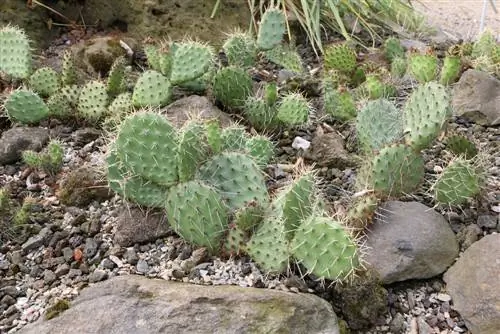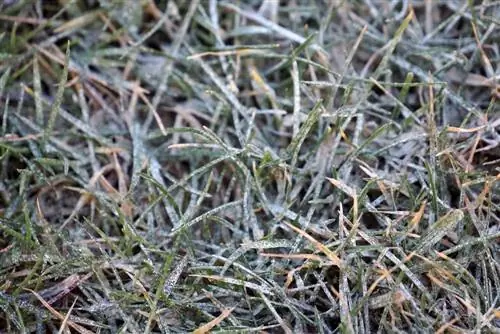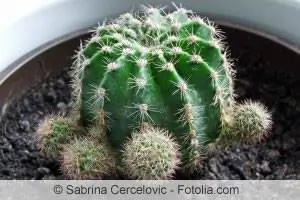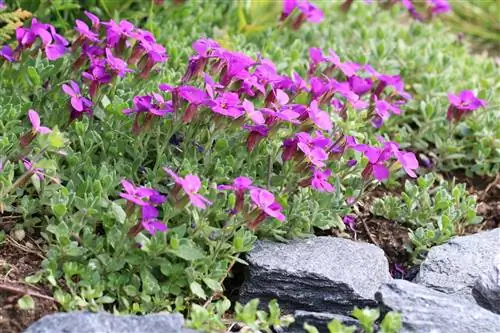- Author admin [email protected].
- Public 2023-12-17 03:39.
- Last modified 2025-06-01 06:48.
A dreary winter garden is never nice to look at. However, if you decide to create a part of your garden with hardy cacti and succulents in a rock garden, you will have a lot of color in your garden even in winter. This means that this rock garden can be created in close proximity to the terrace and can therefore also be seen from the house. And maybe there are even a few days when the sun can be enjoyed on the terrace, all the more beautiful with green plants all around that bring a taste of summer.
Creating a rock garden for the winter
Anyone who creates a rock garden should also think about winter. Because then the area can look very barren without plants. But a rock garden is also suitable for winter, as it can surround the terrace and remind you of summer in winter. In any case, the rock garden, in which the plants also grow in winter, should find its place in the garden in such a way that it can be seen from the house even through the closed windows. A rock garden should always be planted in a bright and sunny place. This is simply because the stones can easily become covered with moss in the shade and when there is not enough sun. Removing the moss takes a lot of effort, so it shouldn't be allowed to form in the first place. Otherwise, the following should be noted for the rock garden in winter:
- choose hardy cacti and succulents
- place these so that they work well on their own in winter
- Early, summer and late bloomers are planted in between
- In this way, the rock garden becomes an eye-catcher all year round
- Create a rock garden only with hardy cacti and succulents
- these also offer an attractive picture in the other seasons
- some plants can be grown in pots
- this loosens up the entire image
- distribute the pots in and around the rock garden
Tip:
Cactus and succulent lovers will get their money's worth with a rock garden with the hardy varieties. This means the rock garden stays green all year round and also becomes colorful in the summer depending on the variety of plants.
Hardy cacti
There are many different varieties of cacti that grow in a wide variety of sizes. For a rock garden with only cacti and succulents, it is therefore advisable to choose plants of different heights from the winter-hardy varieties so that a relaxed picture is created. The following cacti are hardy and can easily be cultivated in a rock garden without having to take any appropriate measures in winter:
Echinocereus
The hedgehog cactus has attractive flowers and thorns. Depending on the variety, it is upright growing, stocky or long-growing and creeping. They form branches on the top where the funnel-shaped flowers also appear. The cactus species can survive low temperatures well and blooms in summer.
Echinofossulocactus
The spherical cactus can grow up to five meters high and reach a diameter of one meter. But it doesn't grow that big in your own garden because it takes up to a hundred years. However, most varieties of these cacti do not produce flowers, but do have an attractive thorny coat.
Tip:
Cacti and succulents with their fleshy leaves have the advantage that they store water for a long time and can therefore survive a longer dry period. If a rock garden has only been created with these plants, there is no need for frequent watering, even in summer.
Escobaria
The spherical cacti have a pad of thorns and the flowers that form in summer are bronze or purple in color. These form on the head of the cactus. The following year small red berries form, but they are not edible.
Ferrocactus
Many different varieties are also grouped together under this Latin name. These desert cacti have strong thorns that are curved into a hook shape at the ends. In the wild, these cacti can grow up to 1.60 meters high and reach a circumference of up to one meter.
Gymnocalycium
Around 50 different varieties of these desert cacti are known, which have the following characteristics:
- spherical-flat
- have bumpy ribs
- interesting thorns
- pretty flowers in different colors
- yellow, white, rose red or red
- funnel-shaped
- rather short in stature
Hamatocactus
The characteristic of these cacti is their single body without side shoots. The yellow, silky flowers form in early autumn or summer. The areoles are white tomentose and sit on the tuberous ribs. This type of cactus is a small plant that grows up to 15 cm high and 10 cm wide.
Mamillaria
This is the largest family of cacti. This includes around 400 different varieties. They tend to form in groups; their bodies are usually squat and spherical or columnar. Other characteristics of these varieties are:
- Warts on the surface
- the thorns grow from here
- blooms from spring to summer
Tip:
The many different types of cacti also have early and late bloomers. If these are cultivated mixed in the rock garden, it will bloom in different places throughout the summer.
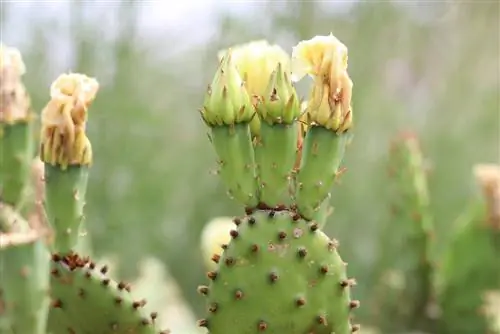
Opuntia
Many different species are known in the genus Opuntia, which can vary greatly in size and growth habit. These can look like this:
- growing upright and hardly branched
- cylindrically shaped dwarf forms growing in groups
- disc-shaped, thorny limbs forming a body
- Species without thorns are also known
- different species form flowers
Pediocactus
All species in this genus grow small and only reach a height of 20 centimeters. They grow spherical or cylindrical and have no ribs. The thorns are located on the small warts. Pediocactus flowers in colors of white, magenta or yellow. The flowering time is in spring, but the first buds are formed in autumn. Reddish-brown fruits are later formed.
Thelocactus
The Thelocactus is characterized primarily by its spherical shape and colorful thorns. The different species bloom in different colors from white to pink to violet, yellow flower colors are also represented. Other features include the following:
- become 25 - 40 centimeters high
- in diameter up to 20 centimeters
- the thorns are on warts
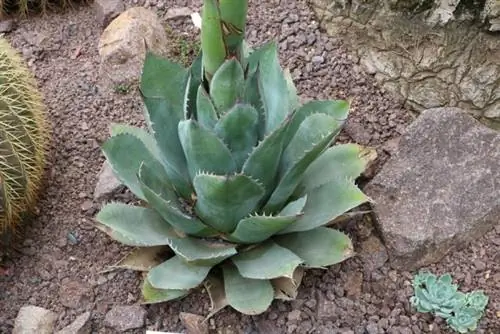
Agave varieties
Agaves are succulents, even if they are not a type of cactus. The special thing about agaves is that they only bloom once in their life. Therefore, the winter-hardy rock garden is more of a green plant. Experiencing a flower is very rare as it requires decades of growth, but it can live up to 100 years. If the agave has enough space, it can grow very large. Other properties of the plant include the following:
- very dangerous and sharp end thorns
- Caution is advised in a household with small children
- protect from contact with end thorns, put on wine corks
- the green, lush, thick leaves grow from the center
- forms many offshoots around it
Varieties of Yucca
Yuccas are very suitable as companion plants for cacti in a rock garden. There are also different varieties of Yucca here:
- short stature
- form a single head up to 50 centimeters high
- colorful varieties
- There are also yucca plants that form a trunk, these are known as yucca palm
- If they are older than ten years, flowers form
Conclusion
There are many varieties of hardy cacti and succulents that can be combined well in a rock garden. There are early and late bloomers here too, which when cultivated together guarantee a blooming cactus garden in summer. In winter the rock garden is evergreen and continues to be an attractive eye-catcher in the garden. Since cacti and succulents don't need a lot of water because they store it, they can survive a longer dry period and are very easy to care for due to their origin, the desert.

